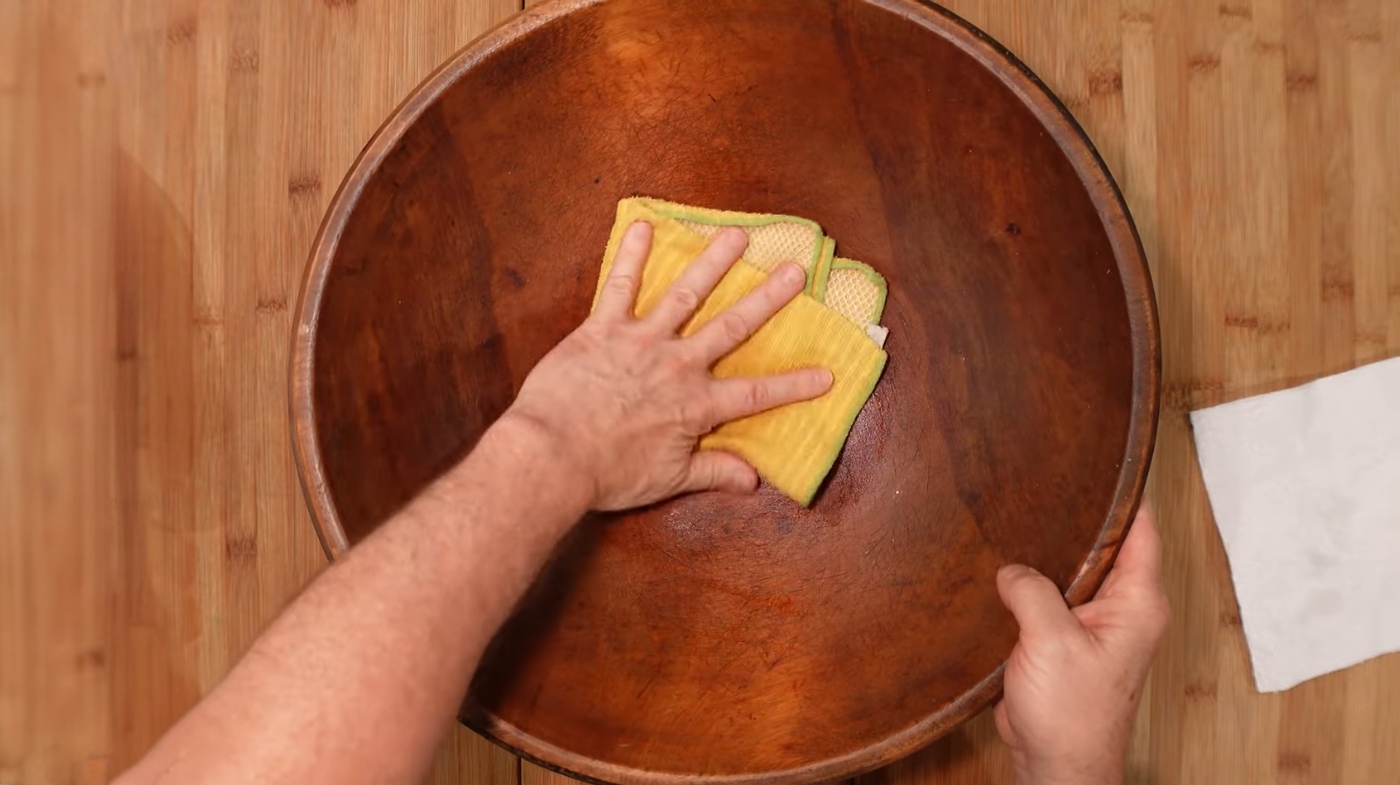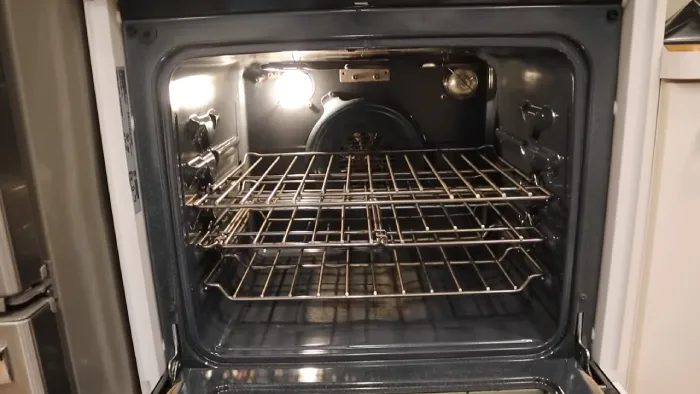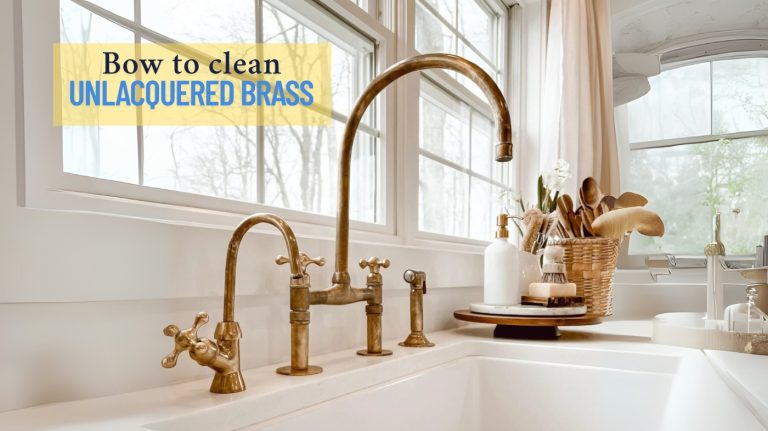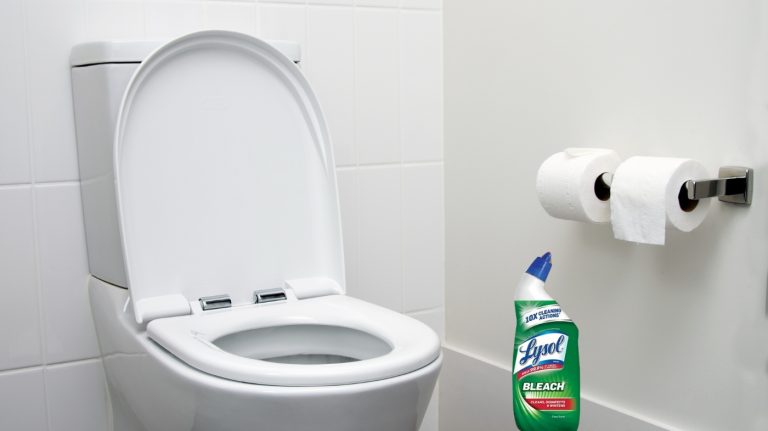How to Clean Wooden Bowls? Easy Steps for a Lasting Shine
To clean wooden bowls, use warm water with mild dish soap and a soft cloth or sponge to wash gently without soaking.
Rinse thoroughly to remove soap, then dry immediately with a towel to prevent moisture damage. For sanitizing, apply a diluted vinegar solution and rinse well.
Avoid harsh scrubbing or chemicals. Proper conditioning and maintenance help keep bowls smooth and durable.
Following these steps guarantees your wooden bowls stay healthy and well-preserved, with additional care techniques available to enhance their longevity.
Key Takeaways
- Wash wooden bowls gently with warm water and mild dish soap using a soft, non-abrasive sponge or cloth.
- Avoid soaking the bowl; rinse promptly to remove all soap residue.
- Dry the bowl immediately with an absorbent towel and air dry in a well-ventilated area.
- Sanitize by wiping with a 50/50 mixture of white vinegar and water, then rinse and dry thoroughly.
- Regularly inspect and condition bowls with food-safe mineral oil to maintain wood quality after cleaning.
Materials Needed for Cleaning Wooden Bowls
Before you begin cleaning your wooden bowls, gather the essential materials to guarantee effective and safe maintenance.
Gathering essential materials ensures effective and safe maintenance of your wooden bowls before cleaning.
For basic cleaning, you’ll need mild dish soap, warm water, and a soft non-abrasive sponge or cloth to avoid scratching.
Absorbent towels are necessary for drying to prevent moisture buildup, and fresh air facilitates thorough air drying. Remember that wooden bowls are not dishwasher safe, so always clean them by hand.
Sanitizing requires a 50/50 mixture of white vinegar and water, a soft cloth for wiping, a dry towel, and a well-ventilated area for drying.
If sanding is involved, prepare fine-grit sandpaper (600 to 1000), steel wool, a dry cloth, work surface protection, and safety goggles.
For conditioning, gather wood bowl conditioner or mineral oil, soft and dry cloths, and maintain a clear workspace.
Proper storage demands a dry, ventilated area, wood preserver, soft cloth, storage containers, and care instructions.
Step-by-Step Cleaning Process of Wooden Bowls
To keep your wooden bowls looking beautiful and lasting longer, follow this simple yet effective cleaning routine that protects and preserves the wood:
Preparing Cleaning Supplies
Gather three essential cleaning agents—mild dish soap, white vinegar, and lemon juice—to prepare for effectively cleaning your wooden bowls.
Select a soft sponge or scrubby sponge to avoid scratching the wood surface. Have a soft, clean cloth ready for wiping and drying.
Prepare materials for drying, such as a dry cloth or paper towel, to promptly remove moisture after cleaning, preventing wood damage. It is important to hand-dry wooden bowls and place them in a drying rack for air circulation to extend their lifespan.
Optionally, keep salt and household bleach on hand for stain removal but use bleach sparingly to prevent wood degradation.
For sanitizing, mix white vinegar and water in equal parts (50/50) to create a gentle, effective solution.
Gentle Washing Technique
Though wooden bowls require careful handling, you can clean them effectively by using mild dish soap mixed with warm water and applying it with the soft side of a sponge to prevent surface damage.
Avoid hot water as it can warp or crack the wood. Never soak the bowl; instead, wash gently and rinse promptly to remove all soap residue. For bowls with film finishes, a light wipe with the detergent solution suffices. Air dry or towel dry to remove moisture quickly after washing.
Follow these steps for the gentle washing technique:
- Use warm water with mild dish soap for cleaning.
- Apply the solution with the soft side of a sponge.
- Rinse thoroughly with clean, warm water.
- Avoid soaking; wash and dry promptly to preserve wood integrity.
Proper Drying Method
Proper drying of wooden bowls involves a carefully managed process to balance moisture loss and prevent damage.
Start by placing the bowl in a loosely closed paper bag to moderate moisture loss, changing the bag daily for 4–5 days until it feels dry.
Then, open the bag to increase air exposure and move the bowl to a dry, ventilated area with stable temperature, avoiding direct sunlight.
Monitor for cracks and use moisture meters or weight measurements to track drying progress.
For small bowls, microwave drying with short bursts and cooling intervals can accelerate drying but must be done cautiously. Alternative methods include desiccants or kiln drying.
Once weight stabilizes and no moisture remains, remove drying aids, allow further air-drying if needed, then sand and finish the bowl to prevent future defects.
How to Sanitize Wooden Bowls Safely?
To sanitize your wooden bowls safely, use natural, non-toxic methods like diluted vinegar to eliminate germs without damaging the wood, follow the steps below.
Vinegar Sanitizing Solution
One effective way to sanitize wooden bowls safely involves using a 50-50 solution of water and white vinegar. This natural disinfectant kills bacteria without damaging the wood’s surface.
Before full application, test the solution on a small, hidden area to verify it won’t harm the finish. Apply the solution with a clean cloth, allowing it to sit briefly to maximize germ elimination.
Follow these steps for proper sanitizing:
- Mix equal parts water and white vinegar in a container.
- Wipe the bowl’s surface thoroughly using a clean cloth soaked in the solution.
- Let the solution stand for a few minutes to disinfect effectively.
- Rinse the bowl with clean water and dry immediately to prevent moisture damage.
Post-Sanitizing Care
After sanitizing your wooden bowl, immediately drying it’s essential to prevent moisture buildup that can lead to warping or mold growth.
Use a clean cloth to remove excess water, then allow the bowl to air dry for several hours in a well-ventilated area. Avoid dishwashers and direct sunlight, as high heat and UV exposure can cause cracking or fading. Hot water washing is acceptable for odor removal, but it should be done sparingly to avoid damage.
Once dry, apply a thin layer of natural mineral oil or food-safe preservers like Bee’s Oil to maintain the wood’s integrity and moisture balance.
Store the bowl in a dry environment with stable humidity, avoiding stacking or pressure that could deform its shape.
Techniques for Sanding and Smoothing
Master sanding and smoothing wooden bowls by carefully selecting your tools and controlling speed to prevent scratches and achieve a flawless finish.
Use a variable speed drill paired with foam-padded mandrels to cushion the sandpaper and protect the wood. Maintain lathe speeds around 300 rpm to improve control and reduce scratching risks.
Always sand following the grain direction to avoid surface damage, progressing through grits from 80 to 120 or finer. Final hand sanding is crucial for areas power tools can’t reach.
Key techniques include:
- Using angled power drills for interior access
- Progressively increasing grit to remove prior scratches
- Regularly inspecting the surface during sanding
- Prioritizing hand sanding for precision and smoothness
Conditioning Your Wooden Bowls
Although sanding and smoothing create a flawless surface, conditioning your wooden bowls is essential to preserve their integrity and appearance.
Conditioning prevents the wood from drying out and developing cracks by maintaining ideal moisture levels. Before applying any conditioner, clean the bowl thoroughly to guarantee proper absorption. Hand washing is the preferred method for woodenware care to avoid damage.
Use food-safe products like mineral oil, food-grade wood conditioners, or oiling waxes containing beeswax or carnauba wax. Apply the conditioner liberally with a cloth, allowing it to penetrate for 5 minutes to several hours, then buff with a dry towel.
After restoration, condition every few days for up to two weeks, then periodically as needed—typically monthly or bi-monthly—to maintain durability, luster, and food safety. Avoid chemical-based products to ensure the bowl remains safe for food contact.
Best Practices for Maintenance and Care
When caring for wooden bowls, consistent and gentle cleaning is crucial to preserve their condition and longevity.
Always hand wash your bowls using warm water and mild soap, avoiding harsh chemicals or abrasive scrubbers that can damage the wood’s finish. Rinse thoroughly and dry immediately with an absorbent towel to prevent moisture absorption.
Deep cleaning techniques, such as using lemon juice or a white vinegar solution, can help remove odors and stains effectively without harming the wood.
Regularly inspect your bowls for signs of wear, sanding rough patches gently when necessary. To maintain ideal condition, implement these best practices:
- Use soft sponges or cloths for cleaning to avoid surface abrasion
- Avoid soaking or exposing bowls to extreme heat sources
- Condition the wood periodically to nourish and protect it
- Buff the bowl after cleaning or conditioning for a smooth, polished surface
Proper Storage and Handling Tips
Since wooden bowls are sensitive to environmental conditions, proper storage and handling play a critical role in maintaining their structural integrity and appearance.
Store bowls in a cool, dry place with stable temperatures between 50-75°F, avoiding direct sunlight, heat sources, and high humidity to prevent warping and mold. Maintaining a consistent humidity level between 35-55% is ideal to keep the wood in good condition.
Keep wooden bowls cool and dry, between 50-75°F, away from sunlight and humidity to avoid warping.
Always hand-dry bowls completely before storage, using breathable cloth covers to allow moisture evaporation and airflow. Avoid airtight sealing to prevent condensation.
Handle bowls with clean, dry hands and avoid stacking; if necessary, use padded separators to prevent damage. Place bowls on surfaces that promote air circulation and prevent tipping.
For long-term storage, seal unfinished wood with appropriate products, store off floors and away from exterior walls, and regularly inspect for moisture or pests. Maintain clean, chemical-free environments to protect wood quality.
Frequently Asked Questions
Can Wooden Bowls Be Used for Hot Soups or Liquids?
You can use wooden bowls for hot soups or liquids, but you need to be cautious. Hardwoods like maple handle heat better, but even then, prolonged exposure to hot liquids may cause warping or cracking if the bowl isn’t well-seasoned and oiled.
Wooden bowls are porous, so hot soups can penetrate and promote bacteria growth. To guarantee safety and durability, avoid extreme heat, clean thoroughly, and maintain the wood regularly with food-safe oil.
Is It Safe to Use Wooden Bowls in the Microwave?
Imagine placing a warm wooden bowl into your microwave, expecting it to heat evenly. However, you shouldn’t do this.
Microwaving wooden bowls causes warping, cracking, and finish damage as heat expands and dries the wood unevenly. This can even create fire hazards.
To protect your bowl’s integrity, avoid microwaving it entirely. Instead, transfer food to microwave-safe containers designed to handle intense, uneven heat safely and reliably.
How Long Does It Take for Wood Conditioner to Fully Absorb?
You’ll find that wood conditioner usually takes between 5 to 15 minutes to fully absorb into the wood surface. This absorption time depends on the wood type and the conditioner’s formulation.
After application with a nylon or polyester brush, wipe off any excess to avoid surface film. For best results, allow the conditioner to dry completely—typically 8 to 24 hours—before applying stain or finishing products.
Can You Repair Deep Scratches in Wooden Bowls at Home?
Did you know over 80% of wooden bowl owners successfully repair deep scratches at home? You can fix deep scratches by filling them with color-matched wood filler or a wood glue and sawdust mixture.
After filling, let it dry, then sand the area smoothly with fine sandpaper. Finally, apply food-safe oil to restore the finish. This process precisely restores your bowl’s surface without professional help or harsh chemicals.
Are Wooden Bowls Dishwasher Safe or Not?
Wooden bowls generally aren’t dishwasher safe because the heat, water, and detergents can cause warping, cracking, and stripping of natural oils.
Unless your bowl is specially treated or sealed for dishwasher use, you risk damaging its structure and finish. Always check manufacturer guidelines, but to preserve your wooden bowl’s integrity and lifespan, avoid the dishwasher and opt for gentle hand washing instead.
Keep Your Wooden Bowls in Top Shape With Simple Care
Although some believe wooden bowls harbor bacteria more than plastic, studies show their natural antimicrobial properties actually inhibit bacterial growth. By following proper cleaning, sanitizing, and conditioning steps, you’ll preserve your wooden bowls’ integrity and safety.
Regular maintenance prevents cracking and warping, ensuring longevity. With precise care and storage, your wooden bowls will remain both beautiful and functional, proving that well-maintained wood is a reliable, hygienic choice for your kitchen.







